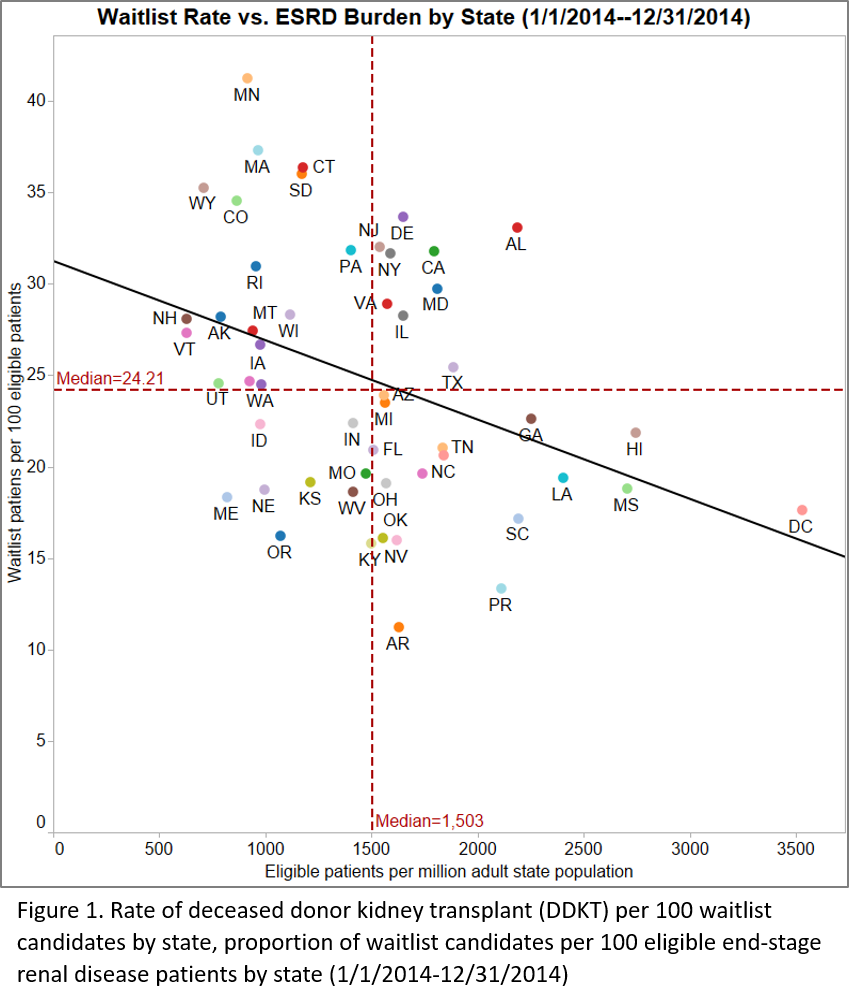Geographic Variation in Listing for Kidney Transplantation: A State-Level Assessment of Access among Patients with End-Stage Renal Disease in the United States
University of Alabama at Birmingham, Birmingham, AL
Meeting: 2020 American Transplant Congress
Abstract number: B-018
Keywords: Kidney transplantation, Renal failure, Waiting lists
Session Information
Session Name: Poster Session B: Kidney Deceased Donor Allocation
Session Type: Poster Session
Date: Saturday, May 30, 2020
Session Time: 3:15pm-4:00pm
 Presentation Time: 3:30pm-4:00pm
Presentation Time: 3:30pm-4:00pm
Location: Virtual
*Purpose: Barriers to deceased donor kidney transplantation (DDKT) exist, including referral for transplant and waitlist addition, which may vary regionally. The objective of this study was to assess the state-level period prevalence of end-stage renal disease (ESRD) patients eligible for DDKT and to measure access to the waitlist among this population.
*Methods: Methods: The 2016 United States Renal Data System database was used to estimate the 2014 period prevalence of adult (18-74 years) ESRD patients eligible for DDKT in 2014, per our transplant center’s standardized criteria (1/1/2014-12/31/2014). Based on UNOS data, the proportion of waitlisted candidates per eligible ESRD patients was calculated. Spearman’s correlation was used to evaluate the association between ESRD burden and proportion of transplant-eligible patients who were waitlisted, by state.
*Results: Among 450,828 ESRD patients identified, 364,358 were eligible for transplant per criteria. ESRD eligible patients varied geographically, and there was significant variation in the proportion of transplant-eligible ESRD patients who were waitlisted, with a mean of 24.84 per 100 eligible patients (Figure 1). A negative correlation existed between state-level ESRD burden and proportion of eligible patients who were waitlisted (r =-0.39, p=0.01).
*Conclusions: Geographic variation existed for waitlisting practices among transplant-eligible ESRD patients, and higher burden of ESRD was not associated with higher proportion of waitlisted transplant-eligible patients. Therefore, waitlist size may be more of a reflection of center/state-level practices than true disease burden. Moreover, on a national and state level, opportunity exists to provide greater access to the waitlist among patients with ESRD.
To cite this abstract in AMA style:
Mustian MN, Qu H, Anderson D, MacLennan PA, Reed RD, Kale C, Orandi B, Shelton BA, Kumar V, Hanaway M, Locke JE. Geographic Variation in Listing for Kidney Transplantation: A State-Level Assessment of Access among Patients with End-Stage Renal Disease in the United States [abstract]. Am J Transplant. 2020; 20 (suppl 3). https://atcmeetingabstracts.com/abstract/geographic-variation-in-listing-for-kidney-transplantation-a-state-level-assessment-of-access-among-patients-with-end-stage-renal-disease-in-the-united-states/. Accessed January 7, 2026.« Back to 2020 American Transplant Congress

